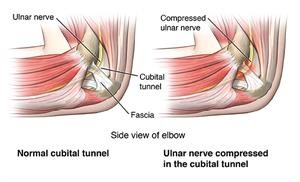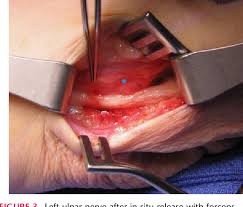Cubital Tunnel Syndrome
The Ulnar Nerve runs around the inner side of the elbow in a groove just behind a bony prominence (medial epicondyle). The nerve, where it lies in the groove, is covered by a layer of tissue which forms a tunnel called the Cubital Tunnel. The ulnar nerve is important as it controls the small muscles in the hand which are particularly important for fine movements such as doing up buttons, gripping and holding cutlery. It is also responsible for normal feeling in the little and ring fingers.
Ulnar Nerve Compression
This is irritation of the Ulnar Nerve as it winds around the back of the inner part of the elbow. It is very common. Almost everyone will have experienced episodes of pins and needles or a ‘dead arm’ after having slept awkwardly or after hitting the ‘funny bone’.
Why does the nerve get compressed ?
There are a number of different reasons why the Ulnar Nerve can become symptomatic.
- The nerve can be compressed by bands of muscle or fibrous tissue in the tunnel behind the elbow.
- Occasionally, the nerve becomes compressed by elbow arthritis or the nerve can be stretched if the elbow becomes misshapen as a result of a fracture or arthritis.

With persistent compression, some people can have pain behind the elbow as well as tingling, pins and needles or even numbness in the little and ring fingers. In the long term it can lead to weakness of the hand and fingers. If your pain/ pins and needles/ numbness are not settled by time, rest and Physiotherapy then surgery may be necessary.
Diagnosis
EMG/Nerve conduction Test – small electrodes are used to assess the compression on the nerve, and in extreme cases, to determine the viability of the muscles.
What is the procedure and what does it involve ?

An incision at the back of the elbow about 10cm long is made inside the upper arm to reveal the Ulnar Nerve. Any tissues which are seen to be compressing the nerve are released; this might include bands of muscle or fibrous tissue or protrusions of bone.
What are the potential benefits of the procedure ?
- To improve your pain and function of the hand
- To improve your feeling in the forearm/ hand.
- To improve your elbow quality of movement.
- Stop deterioration of the condition.

